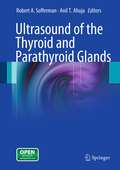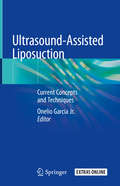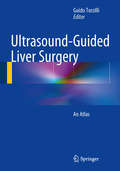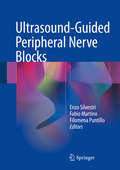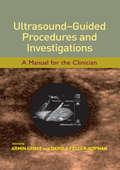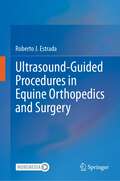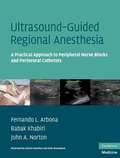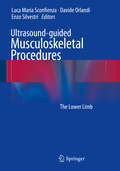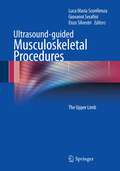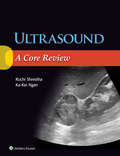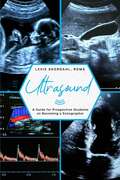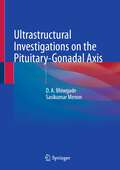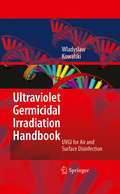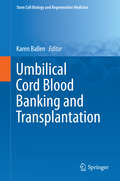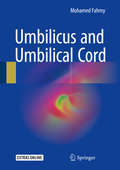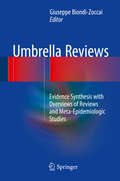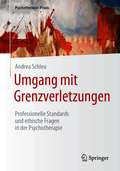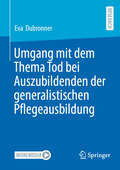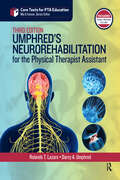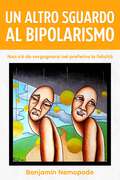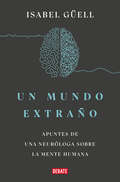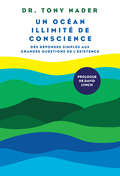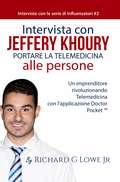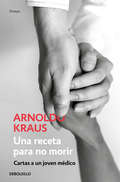- Table View
- List View
Ultrasound of the Thyroid and Parathyroid Glands
by Robert A. Sofferman Anil T. AhujaThis highly illustrated book, complete with comprehensive clinical references and annotated images, will serve as a leading text to educate head and neck surgeons, endocrinologists, and radiologists on the basics and nuances of thyroid and parathyroid ultrasound. It emphasizes the use of ultrasound as an office-based modality by clinicians and radiologists who actively care for this special set of patients. This text uniquely combines the collaboration between a clinician/surgeon and radiologist who share their extensive experience in head and neck ultrasound.
Ultrasound-Assisted Liposuction: Current Concepts and Techniques
by Onelio Garcia Jr.Liposuction is currently the number one aesthetic surgical procedure performed by plastic surgeons in the United States and Americans spend more money on liposuction than on any other aesthetic surgical procedure. Almost 500,000 cases are currently performed yearly by board certified plastic surgeons and it is estimated that at least 20% of the cases are ultrasound assisted. Current ultrasonic liposuction devices are significantly different than the previous generations and require a certain level of technical expertise in order to achieve good outcomes with the technique. Although there are chapters devoted to the technique in general body contouring textbooks, there are no current textbooks that fully cover this important technique.The text is divided into three distinct sections for ease of use. Section I: Fundamentals will cover basic techniques and safe use of the devices for plastic surgeons looking to add ultrasound-assisted liposuction to their practice. Section II: Clinical Applications explores use of the devices for commonly performed surgeries, including facial, trunk, extremity (arm and leg), and buttock contouring as well as gynecomastia. Section III: Special Applications takes a focused look at the VASER device and its use in more complicated situations, with chapters handling silicone injection complications and contouring in a massive weight loss patient. Featuring contributions from leaders in the field, alongside full color photos and a special introductory video, Ultrasound-Assisted Liposuction serves as a reference for surgeons currently using ultrasonic techniques in liposuction and those looking to get started.
Ultrasound-Guided Liver Surgery
by Guido TorzilliUltrasound guidance of liver surgery is a very sophisticated approach that permits the performance of otherwise unfeasible operations, discloses the true extent of tumors, increases the indications for hepatectomy, and renders surgery safer. Despite this, it has remained relatively neglected in the literature over the past two decades, during which time much progress has been achieved. This is the first atlas on the subject, and it is comprehensive in scope. The state of the art in the use of ultrasound for resection guidance is carefully documented, and new techniques for exploration of the biliary tract and facilitation of transplant surgery are presented. Further important topics include the role of ultrasound in laparoscopic approaches, the use of contrast agents for diagnosis and staging, and developments in the planning of surgical strategy. The editor is a leading authority whose group has been responsible for a variety of advances in the field. He has brought together other experts whose aim throughout is to provide clear information and guidance on the optimal use of ultrasound when performing liver surgery. This atlas is intended especially for hepatobiliary surgeons but will also be of considerable value for general surgeons.
Ultrasound-Guided Peripheral Nerve Blocks
by Enzo Silvestri Fabio Martino Filomena PuntilloThis book offers a comprehensive but straightforward, practical handbook on ultrasound (US)-guided nerve blocks. It presents the normal US anatomy of peripheral nerves, clinical aspects of nerve entrapment and different procedures / techniques for each block. Axial or peripheral chronic radicular pain can be particularly severe and debilitating for the patient. The aim of treatment is to provide medium-/ long-term pain relief, and consequently to restore function. The therapeutic nerve block, performed with a perineural injection of anaesthetic, steroid or painkiller, is generally used once conservative treatments have proven unsuccessful and is aimed to avoid surgical options. Ultrasound guidance, offering the direct and real-time visualization of the needle and adjacent relevant anatomic structures, significantly increases the accuracy and safety of nerve blocks reducing the risk of intraneural or intravascular injection and the potential damage to the surrounding structures, but also enhances the efficacy of the block itself, reducing its onset and drug doses. This practical volume addresses the needs of physicians dealing with pain management, e.g. anaesthesiologists, radiologists, orthopaedists and physiatrists, with various levels of experience, ranging from physicians in training to those who already perform peripheral nerve blocks with traditional techniques and who want to familiarize with US guided procedures.
Ultrasound-Guided Procedures and Investigations: A Manual for the Clinician
by Armin Ernst David J. Feller-KopmanRecognizing the increasing importance of ultrasonography in the evaluation and management of patients across a range of medical disciplines, this guide provides illustrative instruction on the performance and interpretation of ultrasound examinations in emergency, critical care, hospital, and outpatient settings.
Ultrasound-Guided Procedures in Equine Orthopedics and Surgery
by Roberto J. EstradaThis book serves as a practical guide for equine veterinarians in orthopedics and surgery. It reviews and summarizes the current scientific evidence of the most commonly performed ultrasound-guided procedures for ultrasound-assisted surgery and injections.For the first time, different techniques are compiled and richly illustrated with pictures and videos to guide the practitioner step-by-step. An initial discussion about the general principles of ultrasound-guided procedures sets the bases for clinicians to understand the general technique and apply it to each approach. Additional chapters describe the most common ultrasound-guided injections in different anatomical structures as well as the surgical approaches that are aided or guided with ultrasound.All over the world ultrasound-guided procedures are performed daily in many different fields of equine practice. The main objective of using these approaches is to increase accuracy and minimize tissue trauma when performing diagnostic and therapeutic procedures. Equine orthopedics and surgery are among the major applications of these techniques.Learn about ultrasound-assisted techniques and be part of this trend! Maximize your capacity as a veterinarian, directly affecting the health of your patients. You can access the supplementary videos directly on your smartphone or tablet; simply download the Springer Nature More Media App for free and scan the links with the play button.
Ultrasound-Guided Regional Anesthesia
by Fernando L. Arbona Babak Khabiri John A. Norton Charles Hamilton Kelly WarnimentRegional anesthesia is a fast-growing field, fuelled by the application of ultrasound technology over the last decade. This book is a technique-oriented guide, which introduces the use of ultrasound technology with practical instruction in the placement of peripheral nerve blocks and continuous perineural catheters. Each procedure is summarized for quick, easy reference, and supplemented by ultrasound images, color photos, and detailed illustrations. Helpful hints and instructions are provided to further optimize block success. Chapters are organized into four sections, focusing on introductory concepts, upper extremity peripheral nerve blocks, lower extremity peripheral nerve blocks and continuous perineural catheters. Written by instructors from a major academic medical center who work in a fast-paced ambulatory setting, this is a key text for residents, fellows and staff physicians who wish to incorporate the use of ultrasound into the scope of their anesthetic practice.
Ultrasound-Guided Regional Anesthesia in Children
by Mannion, Stephen and Iohom, Gabriella and Dadure, Christophe and Reisbig, Mark D. and Ganesh, Arjunan Stephen Mannion Gabriella Iohom Christophe Dadure Mark D. Reisbig Arjunan GaneshUltrasound has revolutionized the practice of regional anesthesia, yet there remains a paucity of good resources on ultrasound-guided regional anesthesia in children. This book offers a much-needed practical guide to all the major ultrasound-guided blocks in pediatric patients, including neuraxial, truncal, upper and lower limb blocks. The core principles of good clinical practice in regional anesthesia are described and discussed, including the pharmacology of local anesthetics in children, the performance of regional anesthesia, the management of complications, and the clinical anatomy of each block. Every block chapter provides both a 'how to' section and also a comprehensive literature review, with an up-to-date and relevant bibliography for reference and further reading. Chapters are illustrated with unique anatomical images and detailed descriptions. Both trainee and experienced anesthesiologists will find this an essential resource for the safe and effective performance of modern regional anesthesia in children.
Ultrasound-guided Musculoskeletal Procedures
by Enzo Silvestri Luca Maria Sconfienza Davide OrlandiThis handbook is a practical, easy-to-use reference that offers step-by-step instruction on ultrasound-guided interventional procedures for treatment of musculoskeletal pain of the lower limb. Each chapter is clearly structured and starts by offering a brief but comprehensive description of the disease to be treated that covers aspects such as epidemiology, etiology, clinical presentation and ultrasound diagnosis. The equipment and drugs needed for each interventional procedure are listed and the procedure itself is then described in detail. Explanatory images and easy-to-read schemes ensure that the reader will be able to follow procedures without difficulty, and helpful practical tips and tricks are highlighted for use in daily clinical routine. This is the sister volume to the previously published Ultrasound-Guided Musculoskeletal Procedures: The Upper Limb from the same editors.
Ultrasound-guided Musculoskeletal Procedures
by Enzo Silvestri Luca Maria Sconfienza Giovanni SerafiniAs it is quick, inexpensive, and non-invasive, ultrasound is the modality of choice for guidance of interventional procedures in the soft tissues. Furthermore, the rising mean age of the general population is being accompanied by increasing demand among patients for minimally invasive procedures to treat painful chronic and degenerative syndromes of the musculoskeletal system. This handbook is a clear, practical guide to ultrasound-guided minimally invasive treatments of musculoskeletal pain in the upper limb. Each chapter is clearly structured, with brief but comprehensive descriptions of the disease to be treated and of the materials and drugs needed. High-quality images and easy-to-follow schemes explain the best approach in each situation, and practical tips and tricks of value in daily clinical routine are provided.
Ultrasound: A Core Review
by Ruchi Shrestha Ka-Kei NganUniquely designed for the Core Exam, Ultrasound: A Core Review covers all key aspects of ultrasound, mimicking the image-rich, multiple-choice format of the actual test. Ideal for residents getting ready for the Core Examination, as well as practitioners taking recertification exams, this one-of-a-kind review follows the structure and content of what you’ll encounter on the test, effectively preparing you for Core Exam success!
Ultrasound: A Guide for Prospective Students on Becoming a Sonographer
by Lexie SkordahlWant to become a sonographer? This is the book for you. This is a step-by-step guide on how to get into ultrasound. It contains information on... How to get your pre-requisites How to apply to a sonography program How to acquire all your volunteer and job shadow hours prior to application How to get your first job This book also covers... What ultrasound really is - explains all the exams and procedures What an ultrasound program is like and what to expect What to expect during clinicals What credentials you need and how to get them and more!
Ultrastructural Investigations on the Pituitary-Gonadal Axis
by D. A. Bhiwgade Sasikumar MenonThis book provides the ultrastructural study of the pituitary–gonadal axis through the electron microscope. It is a compilation of extensive work carried out by Dr. D.A. Bhiwgade and his researchers over the last four decades. It explains the ultrastructural characteristics of pituitary cells in different morphological states and provides a comprehensive approach to identifying the structural and functional distinctions between various pituitary cell types. The book includes ultrastructural evaluations of the testis and epididymis after different experimental interventions to study the physiological correlations of the organs with spermatogenesis and the consequent structural deformities in sperm. An extensive section of different types of placentae is added for understanding the varied interactions of fetal and maternal tissues in the placental barrier. Placental types seen in bats, shrews, rodents, and monkeys are explained at the ultrastructural level to distinguish the tissue interrelationships within different placental layers. Detailed sketches have been provided to illustrate the correlations between the maternal and fetal tissues in different placental types for better understanding. This book is a ready reckoner and offers guidance to researchers and clinicians in understanding the cellular architecture and intracellular changes associated with various physiological states and clinical conditions of the pituitary, testis, epididymis, and placenta. This book offers assistance to all those using electron microscopy to evaluate cellular and tissue systems.
Ultraviolet Germicidal Irradiation Handbook
by Wladyslaw KowalskiThis book is a comprehensive source for technical information regarding ultraviolet germicidal irradiation (UVGI) and its application to air and surface disinfection for the control of pathogens and allergens. The primary focus is on airborne microbes and surface contamination applications for hospitals, commercial facilities, and residential homes. All aspects of UVGI systems, including design methods, sizing methods, modeling, safety, installation, testing, guidelines, and disinfection theory are addressed in detail. An extensive database of over six hundred UV rate constant studies is included as well as tabular performance data for UV lamps and products. Providing this information in one single source simplifies the design and installation of UVGI systems, helps guarantee effective performance of new systems, and facilitates their use on a wide scale for the purpose of improving human health. This book is organized to provide systematic coverage of all related issues and will serve equally well as both a textbook and a handbook for general reference.
Umbilical Cord Blood Banking and Transplantation
by Karen BallenThis comprehensive volume discusses the current scope of umbilical cord blood transplantation (UCBT), including recent controversies and future developments for improving clinical outcomes. Its twenty chapters introduce new applications in regenerative medicine and discuss the latest scientific, regulatory, clinical and investigational aspects of cord blood banking. Physicians from around the world provide a global collaboration which explores strategies for umbilical cord blood expansion, homing, unit selection, and combining of graft sources to improve patient outcomes. Umbilical Cord Blood Banking and Transplantation also reviews advances in pediatric UCBT for hematologic and non-hematologic disorders as well as immune recovery, which is critical to preventing infection. Finally, it compares UCBT with other graft sources in an attempt to understand the optimal graft source for the individual patient. UCBT is an important option for many patients who need a transplant but do not have a family donor or a matched unrelated donor. The collective and timely knowledge presented here is essential reading for any regenerative medicine investigator, cord blood banker, transplant laboratory scientist or clinical physician interested in improving and expanding the applications of umbilical cord blood.
Umbilicus and Umbilical Cord
by Mohamed FahmyThis book discusses the importance of umbilical cord and umbilicus as a unique structure, in health and in different diseases. All congenital anomalies of the umbilical cord as well as acquired diseases are explained and discussed with illustrations and animations.Starting from complications during and after birth, the book then covers childhood and adolescent umbilical abnormalities. Conditions such as umbilical stump diseases and anomalies, gastroschisis, omphalocele and urachal anomalies are discussed and explained, highlighting recent advances in their management. Among the contents are also chapters offering a cultural and historical perspective to the topic.Written by a top pediatric surgeon this book brings decades of practical knowledge to readers, highlighting the importance of the umbilicus in development and childhood health.
Umbrella Reviews
by Giuseppe Biondi-ZoccaiThis book is an ideal guide to umbrella reviews, overviews of reviews, and meta-epidemiologic studies for evidence synthesis. Research is conducted at different levels: primary research consists of original studies while secondary research comprises qualitative reviews, systematic reviews, and meta-analyses. Recently, a novel further level of research has been introduced, based on the analysis and pooling of reviews and meta-analysis. This book is the first to focus solely on this new type of research design, which permits a comprehensive and powerful synthesis of scientific evidence in medicine as well as in many other fields in order to inform decision-making. All aspects are covered, including review design and registration, the searching, abstracting, appraisal, and synthesis of evidence, the appraisal of moderators and confounders, and state of the art reporting. Case studies in a range of medical specialties are then presented. The hands-on approach of the book, written by a multinational team of experts, will enable the reader to interpret and independently conduct umbrella reviews.
Umgang mit Grenzverletzungen: Professionelle Standards und ethische Fragen in der Psychotherapie (Psychotherapie: Praxis)
by Andrea SchleuDas Buch setzt sich lebendig und anhand vieler anschaulicher Beispiele mit schwierigen Behandlungssituationen in der Psychotherapie auseinander. Einen Orientierungsrahmen bieten Ethikleitlinien, Berufsordnung und wissenschaftliche Erkenntnisse, die jedoch keine abschließenden Antworten geben können. Das Buch führt in einen offenen Diskurs über den Umgang mit Irrtum, Verwicklung, Grenzen und Grenzverletzungen, von dem sowohl Aus- und Weiterbildungsteilnehmer als auch erfahrene Kollegen profitieren können. Vor dem Hintergrund des aktuellen Stands der Forschung und der rechtlichen Rahmenbedingung wird jenseits von Tabuisierung und Schweigen ein hilfreicher Umgang mit der Dynamik von Grenzverletzungen und Machtmissbrauch in der Psychotherapie entwickelt. Die teils gravierenden Folgen für Patienten und Psychotherapeuten sowie die gesamte Profession werden eingehend erörtert und Maßnahmen zur Prävention dargestellt. Aus dem Inhalt: Grenzverletzungen – Abstinenzverletzungen – Machtmissbrauch – Machtgefälle – Behandlungsfehler – Regelverstöße – Nebenwirkungen – Therapieschäden – professionelle und ethische Standards in der Psychotherapie – Ethikverein – Folgetherapie – Prävention – politische Konsequenzen. Die Autorin: Dr. med. Andrea Schleu, Fachärztin für Psychotherapeutische Medizin und Innere Medizin, Psychoanalyse (DGPT), EMDR (EMDRIA), Spez. Psychotraumatologie (DeGPT), Supervision (DGSv), Dozentin, Referentin, Beraterin und Vorsitzende Ethikverein e.V.
Umgang mit dem Thema Tod bei Auszubildenden der generalistischen Pflegeausbildung
by Eva DubronnerDie wissenschaftliche Arbeit steht unter der Zielsetzung, den Stellenwert des Themas Tod bei Auszubildenden der neuen generalistischen Pflegeausbildung zu erforschen und zu untersuchen, inwieweit sich das Todesbewusstsein durch Zunahme von Fachwissen seitens des berufstheoretischen Unterrichts und durch berufspraktische Erfahrungen und Begegnungen mit Sterbenden und trauernden Angehörigen bei den Auszubildenden verändert. Die Erfassung und Bewertung der thanatologisch- und praktischen Erlebnis- und Darstellungsform wird mithilfe von leitfadengestützten Interviews exploriert und Unterschiede mit Blick auf die Thematik zwischen Auszubildenden des ersten und dritten Ausbildungsjahrganges dargestellt. Darüber hinaus werden die Befunde der qualitativen Erhebung in den curricularen Kontext gestellt und Handlungsoptionen für den berufstheoretischen Unterricht der dreijährigen Pflegeausbildung zum Thema Tod gegeben. Die Thematisierung der Endlichkeit- und Vergänglichkeitsthematik mittels leitfadengestützten Interviews versteht sich als eine der ersten wissenschaftlichen Beiträge zur Erhebung des Todesbewusstseins bei Auszubildenden der neuen generalistischen Pflegeausbildung.
Umphred's Neurorehabilitation for the Physical Therapist Assistant (Core Texts for PTA Education)
by Darcy Umphred Rolando LazaroA comprehensive guide to neurological rehabilitation for physical therapist assistants (PTAs), Umphred’s Neurorehabilitation for the Physical Therapist Assistant, Third Edition presents contemporary, evidence-based principles and techniques for examination and intervention for individuals with neurological conditions.Umphred’s Neurorehabilitation for the Physical Therapist Assistant, Third Edition addresses a wide variety of pediatric and adult neurological disorders, including spinal cord injury, brain injury, stroke, Parkinson’s disease, multiple sclerosis, amyotrophic lateral sclerosis, Guillain-Barré syndrome, and more.Drs. Lazaro and Umphred have updated this classic text to reflect current and emerging trends in physical therapy, including: The role of the PTA in neurocritical care The role of the PTA in management of clients with lifelong impairments and activity limitations Technology in neurorehabilitation Also included is a new chapter on functional neuroanatomy, which provides the foundational background for understanding the relationship between the structure and function of the nervous system.The Third Edition also features helpful instructor and student resources. Included with the text are online supplemental materials for faculty use in the classroom.Umphred’s Neurorehabilitation for the Physical Therapist Assistant, Third Edition is the definitive resource for any PTA faculty, student, or clinician interested in the physical therapy management of individuals with neurological conditions.
Un altro sguardo al bipolarismo: Non c’è da vergognarsi nel preferire la felicità
by Benjamin NemopodeL’incredibile percorso di un uomo con il disturbo bipolare Come è sprofondato nella più profonda disperazione, per poi uscirne trionfante. Ti è stato diagnosticato il bipolarismo? Conosci qualcuno che soffre di questa malattia e che lotta per ritrovare se stesso? Vorresti saperne di più di questo terribile disturbo psicologico? Sei alla ricerca della pace o sei interessato al buddhismo? Disturbo bipolare o verità del risveglio spirituale? Segui il viaggio di Arthuro Jobsquare, bipolare, da Parigi a Montreal, passando per Londra, fino allo stato di buddha. Un’avventura fantastica, uno scacco al bipolarismo. Un’incredibile determinazione nel voler superare la malattia che minacciava di controllarlo per sempre. Descrizione della malattia e dell’incredibile percorso di un bipolare di tipo I. Questo libro espone l’incredibile percorso di una persona bipolare fornendo una descrizione corretta e accurata della malattia. Se cerchi un libro sul disturbo bipolare o sul risveglio spirituale, non cercare oltre, l’hai trovato... Ordina SUBITO la tua copia e inizia il tuo percorso di risveglio. Estratti dalle recensioni di lettori Amazon ★★★★★ “L’autore condivide con noi il suo doloroso percorso di vita con il disturbo bipolare di tipo I. Una testimonianza toccante, compiuta e scritta splendidamente...” - Frédérique Madison (Francia) ★★★★★ “Ho letto questo libro in più tempi, cosa che non è mia abitudine fare. Ma ogni tanto ho dovuto fermarmi a riprendere fiato. Si sente chiaramente tutta la sofferenza di una persona che cerca di prendere le distanze dalla propria esperienza...” - Armand Poursin (Francia) ★★★★★ “Consiglio questo libro in quanto utile complemento alle proprie ricerche sulla malattia e anche come testimonianza di chi ne è affetto. Ora posso dire di averla compresa molto più chiaramente e di amare
Un mundo extraño: Apuntes de una neuróloga sobre la mente humana
by Isabel GüellUnlibro que nos invita a maravillarnos ante la complejidad de la mente humana.A través de casos clínicos y con la pandemia como telón de fondo, este libro explora el extraño mundo de las enfermedadesneurológicas y juega con nuestra forma de experimentar el día a día para guiarnos por los maravillosos caminos de la mente.Gracias a su dilatada experiencia como neuróloga y su enorme capacidad divulgadora, la doctora Isabel Güell se asoma al ámbito del recuerdoy la memoria, de las emociones, de los sentidos, del libre albedrio, del lenguaje o de la personalidad. Cuestiones complejasy enigmáticas que no solo demuestran la curiosidad, laerudicióny la empatía de la autora, sino que, en su conjunto, se convierten en una espléndida indagación de la naturaleza humana.El resultado es un libro vibrante y luminoso, escrito desde la pasión por los demás y con un gran talento literario que encaja en latradición de autorescomo Oliver Sacks, donde la ciencia y la literatura caminan de la mano para convertirse en fuente de conocimiento y reflexión.
Un océan illimité de conscience
by Dr. Tony NaderDes réponses simples aux grandes questions de l'existence. Prologue de David Lynch. «Dans ce livre qui fera date, les idées que développe le Dr Nader ont le pouvoir de changer le monde. Il apporte des réponses fondamentales aux questions qui ont fasciné et intrigué depuis longtemps philosophes et scientifiques. Qu'est-ce que la conscience, sommes-nous libres ? Comment réussir au mieux sa vie, réaliser ses désirs, susciter la paix et l'harmonie entre les êtres humains et les pays ? À toutes ces questions, il apporte des solutions fondées sur un paradigme fondamental et simple qui unifie l'esprit, le corps et l'environnement en un océan unique d'Être pur, de conscience pure. Un livre que toute personne à la recherche de la vérité ultime et absolue se doit de lire.»David Lynch «Je veux que toute le monde sache ce qu'est la conscience et comment la développer pour profiter du plein potentiel de la vie individuelle et sociale.»Dr. Tony Nader
Un'intervista con Jeffery Khoury
by Richard G Lowe Jr Vita CumboQuesto libro riporta l'affascinante intervista dell'autore a Jeffery Khoury un giovanissimo imprenditore che ci presenta la sua applicazione innovativa che permette l'applicazione medicina telematica nella vita di tutti i giorni, pensata per chiunque. Parliamo di una vera e propria avanguardia sul mondo delle applicazioni per i nostri cellulARI e, insieme, sul modo nuovo di connettersi con il proprio dottore. Questo giovane ragazzo ci spiega come sia semplice per tutti usare questo nuovo strumento, come è nata questa brillante idea e gli sforzi per realizzarla, dandoci anche una preziosa lezione di vita.
Una receta para no morir: Cartas a un joven médico
by Arnoldo Kraus«Arnoldo Kraus ha hecho de su vida una pasión por la muerte, o más bien una pasión por la vida y por el bien morir.» Eduardo Matos Moctezuma En esta obra, Arnoldo Kraus ofrece una visión integral y sucinta sobre saberes, coyunturas y deudas que ha debido adquirir, enfrentar y resolver a lo largo de sus años en el ejercicio de la medicina. El sustento de estas reflexiones es la experiencia práctica, pero no sólo ella; también varias lecturas, una posición de compromiso ético y la certeza de no saberlo todo. Tanto los aspirantes a médico como los lectores en general encontrarán aquí motivos para confiar en que no se ha roto definitivamente el vínculo entre humanismo y medicina.
